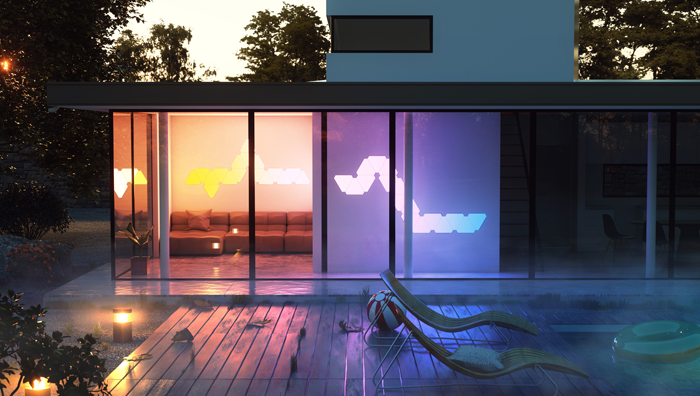

Looking for a piece of wall art that doubles as lighting for your home?
You’re in luck. Aurora, launched by Canadian smart-lighting startup Nanoleaf, is a set of smart LED panels designed to go on your wall.
The panels are triangular (about 9″ on each side), and can be connected to basically make any shape or design you want. Nine come in a set, and you can buy packs of three more to create more intricate designs. They are connected by a small “chip” that literally connects the two together. Since they connect together only the first panel needs to be plugged into the wall.
-

img_6990
-

img_7565
-

img_1330
Each panel can essentially be lit up with any color on the color wheel, meaning there are millions of different shades you can pick. And once connected each panel can show their own color, all light up with the same shade, or “play” animated scenes – like colors mimicking a sunrise or waterfall.
Aurora is controlled by an iPhone and Android app, which is pretty smart. Once paired it will automatically identify what layout you arranged your panels in and mimic that on your phone.
 From within the app you can tap on colors to change them, as well as adjust brightness, speed, etc. There is also a physical button on the first panel (the one with the power cord) so you can turn it on or off without using the app.
From within the app you can tap on colors to change them, as well as adjust brightness, speed, etc. There is also a physical button on the first panel (the one with the power cord) so you can turn it on or off without using the app.
Aurora is also Apple HomeKit compatible, so once paired you can control the lights from within HomeKit.
While an Aurora design looks cool when mounted on the wall, it’s not exactly the best option if you’re just looking for a traditional light source. When testing it none of the colors really mimicked a neutral lighting, and I wouldn’t want to have to rely on the panels for a source of light alone.
Essentially if you’re looking for a new lamp and get Aurora you’re probably going to be disappointed. But if you’re looking for a cool conversation piece for your wall, Aurora may be a good option.
That’s why I see this as being a piece that would be great for a media room or game room – but not necessarily your living room or office. While you could always turn the brightness down or pick a neutral color to illuminate Aurora, the lights are a little too bright and colorful to look at all day.
-

img_8874
-

img_9420
-

img_2737
-

img_0106
-

img_6928
One more thing – Aurora is a hassle to put on your wall.
The panels don’t necessarily stay connected together that well so you’ll have to make sure each one is mounted really well before you can mount and connect the next. Plus, since you organize the panels to make your own shape, it’s really important to measure and make sure each panel is in the right spot and level – or else your either design will be messed up.
The kit comes with those 3M damage-free hanging strips with the pullable tabs that are supposed to be easily removable, but as I learned removing the panel after mounting them is easier said than done – especially if you want to hide those tabs so they aren’t sticking out.
But if you have the patience to hang them and creativity to organize the panels into a cool design, Aurora could really spruce up a boring wall.
The starter kit with nine panels retails for $199.99, and the expansion pack of three panels retails for $59.99. Expensive for lights, but again – you need to think of Aurora as wall art, not lights.
Ultimately, if you’re just looking for smart HomeKit-enabled lighting, you’re better off buying smart bulbs from the multitude of companies that are now selling them (including Nanoleaf). But if you want a really cool piece of wall art and are willing to put up with a slightly frustrating installation process, Aurora may be for you.


